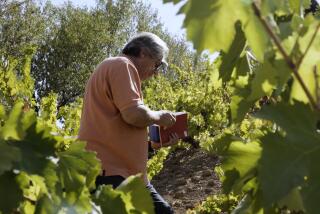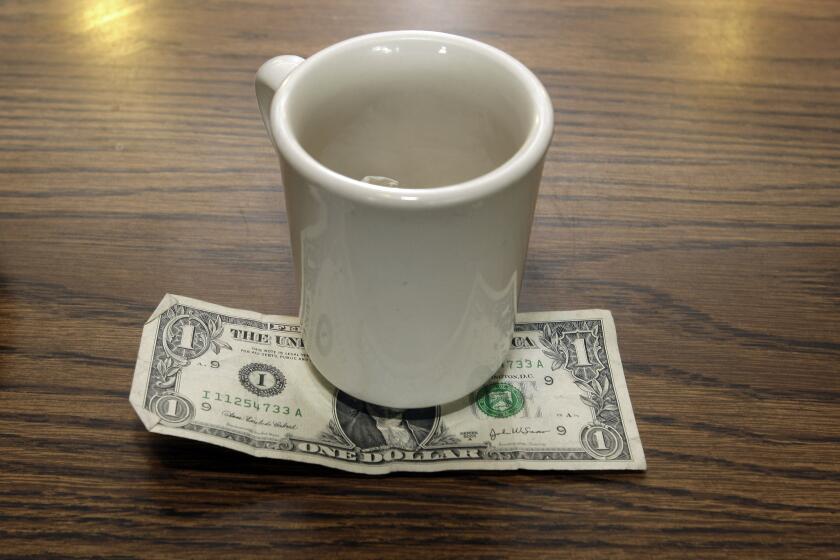Sealed With a Twist
- Share via
The sommelier presented the bottle with a flourish. I checked the label and nodded. He drew himself up and held the bottle before us like a religious object, gazing beatifically at a point somewhere over our heads. Then, with a deliberate, elegant motion, he unscrewed the cap.
We were at Nahm, one of London’s best new restaurants and the first Thai restaurant to receive a Michelin star. The wine was one of Australia’s finest Rieslings, a Mt. Horrocks 2002 from Watervale, in the Clare Valley north of Adelaide. We thought it would be perfect with the Thai feast we were about to enjoy in the beautiful honey-colored dining room at the cutting edge of London’s burgeoning restaurant scene.
It was indeed perfect, and then some. Its lime-peach fruit, vibrant acidity and pinpoint balance played in and out of the complex flavors and textures of dish after dish. And when it was time to order another bottle, we did so knowing it would be just as wonderful as the first, thanks to the reliable screw cap.
Like it or not--and many wine lovers aren’t sure they do--the screw cap is here to stay. After decades of flirtation, high-end wine producers are making a serious commitment to the cork alternative once thought suitable only for jug wines. And California, the premium-wine capital, is at the forefront of the movement in America.
By most current estimates, 3% to 5% of all cork-finished wines are compromised by the cork. The problem is caused by a naturally occurring microorganism (trichloroanisole, or TCA, if you absolutely must know) present in the oak tree bark from which corks are made. The bacteria secrete one of the most highly aromatic compounds known to science, which can introduce off-aromas and flavors to individual bottles of even the best wine. A badly corked wine smells like a wet dog. Even at sub-threshold levels a bad cork can deaden the wine’s aromatic freshness.
Cork-tainted wine has always been like the weather: Everyone complains, but nobody does anything about it. Finally, several years ago some Australian producers boldly decided to eliminate corks altogether.
Mt. Horrocks’ proprietor, Stephanie Toole, was among the innovators, a group of Clare Valley Riesling producers led by the Riesling master Jeffrey Grosset and including labels such as Mt. Horrocks, Grosset, Queltaler, Knappstein, Petaluma and several others.
“We finally decided that if we’re serious about people laying our wines down for 10 years, we have to do something about the cork problem,” said Grosset. “It’s just not fair to expect our customers to cellar our wines with the risk that a certain percentage will be tainted.”
It’s no accident that Riesling producers took the initiative. They’re particularly susceptible to the problem. “Riesling fruit in particular is so delicate and complex that it can be tainted by the most minute levels of TCA,” says Grosset.
“In fact, many of us have long suspected that the presence of this piece of wood in the mouth of the bottle may compromise Riesling fruit even without TCA contamination.”
The Clare producers collectively bottled most of their vintage 2000 Rieslings in distinctive blue bottles with metal screw-cap closures called Stelcaps, a cosmetic update of the French-made Stelvin closure, developed in the late 1950s.
The next year virtually all the Clare Valley and Eden Valley Riesling producers went to Stelcaps. Last year they were joined by a number of other producers in Australia. Southcorp, Australia’s largest wine group, bottled all its 2001 Rieslings with Stelcaps under the Penfolds, Rosemount and Wynn’s labels. Several New Zealand wineries got on board, too.
Early this month, the movement spread to the Northern Hemisphere when Oregon’s Argyle Winery (owned by the prominent Australian vintner Brian Croser) announced it would bottle most of its 2002 wines with caps. And California’s own Randall Grahm said he will bottle about 80,000 cases of red and white Bonny Doon wine with Stelvin screw tops. Sonoma-Cutrer has also bottled some of its Chardonnay with screw caps, and Downing Vineyards has done the same with some 200 cases of Napa Valley Zinfandel.
By my count, more than 50 premium winemakers--primarily in Australia, New Zealand and the U.S.--are bottling all or part of their production under screw caps.
The screw cap is a roll-on, tamper-evident closure composed of a threaded aluminum alloy cap with a multilayered liner. Compression of the liner against the glass creates a neutral, airtight seal. It’s been the closure of choice for spirits, oils and other perishable liquids for more than 30 years.
Winemakers have long kept their own collections of library wines under screw cap because they know that it will protect better than cork.
The last bastion of cork, upscale reds, may fall to innovation sooner than anyone thinks. Jeffrey Grosset bottled his 2000 Gaia red blend under Stelvin (Stelcap’s more robust cousin).
PlumpJack, an upscale Napa Valley producer, has bottled a portion of its Reserve Cabernet under screw cap since the 1997 vintage. Now 300 cases of the 1999 are offered at $155 a bottle, a clear signal that alternatives to cork are being investigated at every level.
The benefits of non-cork closures have long been known. Several years ago I tasted an experimental screw-capped bottling of Henschke Eden Valley Riesling side-by-side with their regular cork-finished Riesling. The wines were several years old, and it was clear that the cap kept them bright and fresh longer than cork.
Yet most premium-level wine producers have been reluctant to take the plunge, fearing a loss of cachet if they use a closure associated with cheap wines. In 1991, Glen Ellen tried a limited experimental release of Dolcetto in screw top; customer response was not encouraging. And cost is a complicating factor. The new closures require specially made bottles and bottling equipment.
Grosset says, “We think the time has come to make this commitment. We owe it to our customers, and to the wines themselves. The horse and cart was irreplaceable two centuries ago, and perhaps the fax machine two decades ago, but not anymore. The same is true of cork. But we still recognize that it’s risky for a single producer. So we decided to take a stand together.”
It makes a lot of sense to me. Still, I can’t help feeling bad for generations of wine lovers raised on corks. Especially sommeliers. The rise of the screw cap threatens to deprive them, and their customers, of a dignified tableside ritual that has been part of the enjoyment of wine since the first cork-finished bottlings some two centuries ago: drawing the cork, examining it and solemnly tasting the wine to make sure it’s sound.
It could even spell the end of that most noble of specialized instruments, the corkscrew. One of those rare tools that has only one application, the corkscrew is an arcane and storied contraption.
In its purest form, the classic waiter’s knife, it is an archetypal artifact, incorporating several of the fundamental elements of engineering that have enabled human progress: the screw, the lever, the spring and the sharpened blade.
It even hints at the wheel in the way its parts swivel in and out of the handle on tiny axles. For the sommelier, it’s a tool of the trade with totemic status, like the carpenter’s hammer, the fielder’s glove, the fireman’s ax.
I love using mine. Like most of the sommeliers I know, I paid a pretty penny for it. It’s a precision-engineered stainless steel beauty from the French artisanal knife maker Lagouille. Its fine weight and polished contours feel good in my hand, and it removes cork from bottle like magic.
I keep it in a leather case and use it to open special wines, when a serviceable but ordinary corkscrew falls short of the occasion.
I hate to think how many times I’ve used that excellent tool to remove a cork that has irrevocably ruined the wine in a bottle I’d been cellaring, and anticipating, for years. Would I miss that if the cork became an anachronism? Certainly not. Would I miss the cork-pulling ritual? Absolutely.
In the 1980s there was a vogue among the so-called boutique wineries for closing bottles with sealing wax. Getting through the wax to the cork could be frustrating and messy. I still have a pair of steel tongs designed to do the job, although--thank God--the days of wax closures appear to be firmly sequestered in the past.
I hope someone comes up with an interesting tool for removing screw caps, if only to give the sommeliers some stage business so they won’t feel foolish simply twisting a wrist and pouring.
*
Rod Smith is writer-at-large for Wine & Spirits magazine.
More to Read
Eat your way across L.A.
Get our weekly Tasting Notes newsletter for reviews, news and more.
You may occasionally receive promotional content from the Los Angeles Times.










